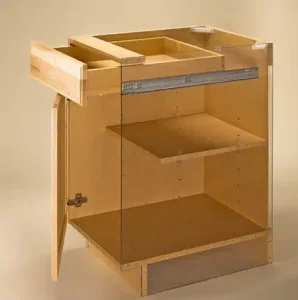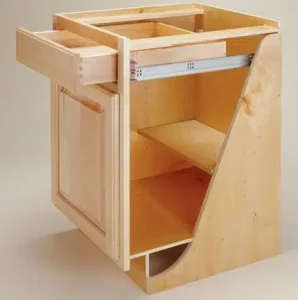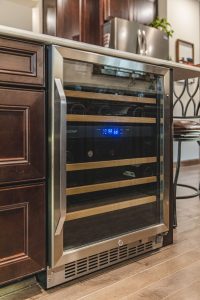Many consumers choose European frameless cabinets over more traditional framed cabinetry because they want extra storage. This shouldn’t come as a surprise considering that the need to maximize storage space in a kitchen typically serves as the driving force behind many kitchen selections. The decision-making process is frequently incorrect or the advantage is overestimated, though.
Let’s calculate how much extra space frameless cabinets provide compared to more robust framed cabinet construction.

Featured Image: Frameless Cabinet. Photo: Mainline Kitchen Design
An illustration of a frameless-built cabinet in the cross-section is shown above. Keep in mind that the cabinet box consists just of a back, a top, a bottom, and sides. The cabinet’s front is missing. Here’s an illustration of a framed cabinet. Take note of the cabinet’s front frame, through which the drawer slides and to which the hinges and other components are fastened.

Featured Image: Framed Cabinet. Photo: Mainline Kitchen Design
Better-framed cabinets often have sides 1/2″ thick and a face frame made of solid wood that is 1 1/2″ wide and 3/4″ thick on both the horizontal and vertical axes. Better-built frameless cabinets have sides that are 3/4″ thick and don’t have any front at all. This means that with a frameless cabinet, as opposed to a framed line, all of the hinges and drawer tracks are mounted to plywood or particleboard sides. All rollouts, drawers, and pullouts must, however, fit through the smaller aperture in the front of a framed cabinet.
What is the storage difference between the two choices?
Let’s calculate!
First, since the dimension of a cabinet’s inside is the same in both the framed and frameless versions, the inside of both boxes is practically the same. The frame does occupy a very small amount of space, however, it makes up significantly less than 1% of the entire cabinet area. Only the rollouts and drawers experience a substantial reduction in the area as a result of the moving pieces having to fit through a narrower cabinet front aperture. This also implies that the quantity of space in framed and frameless wall cabinets is equal. This is because drawers and rollouts are only usable in base cabinets and the bottoms of tall cabinets.
Every drawer or roll-out in every cabinet will lose 3/4″ of space on each side, making every drawer’s interior 1 12″ narrower in a framed line than in a frameless line. This implies that the storage capacity of any drawer or roll-out is decreased by around 8% for an average cabinet with a width of 24″. Less when the cabinet is broader and more when it is narrower. The average reduction in storage space caused by a cabinet with all drawers or all rollouts is 8%. A cabinet with just the top drawer would only use up the space in that drawer, while the storage space in the drawers below would remain unchanged. Therefore, a conventional base cabinet with just a top drawer would lose no more than 2% of its overall storage space without rollouts. Due to a few minor aspects that we have excluded from the calculations, we have simplified the calculations while simultaneously being generous with the total storage savings.
Today’s kitchens employ more drawers and roll-outs than ever before, so let’s estimate 6% of all the bottom cabinetry is lost, assuming that most tall and base cabinets have drawers or roll-outs on the bottom. The overall storage capacity in the kitchen won’t decrease by more than 4% when employing framed vs. frameless cabinets because none of the storage at the tops of tall cabinets and wall cabinets takes up any additional space.

It’s not a big deal to lose 4% of your storage capacity. As opposed to a design that uses a cooktop, a wall oven, and a microwave wall oven with a hood over the cooktop, choosing a range and a microwave hood above it in a kitchen can save 10% of the total storage in a small kitchen. In a small kitchen, dividing the cabinetry to create small spice pull-out cabinets or tray divider cabinets can result in a 4% efficiency loss. In a small kitchen, even putting attractive 3′′ broad legs on either side of a stove or sink would reduce base cabinet capacity by 5%, and by 10% if you added them in both locations.

Because there is no solid wood front on the cabinet, frameless cabinetry is less sturdy than framed cabinetry. The cabinet box is protected by the cabinet fronts, and the edges of frameless cabinet fronts have at most a 1/4″ thick edge banding. Well-made framed cabinetry is capable of withstanding wear and tear over a lifetime since the hinges and tracks are connected to the strong wood frame and each frame is screwed to the face frame next to it. Face frames do obstruct vision, which is why “easy access cabinetry” is another name for frameless cabinets.
After performing these space calculations and considering the durability concerns, we do not advise adopting frameless cabinetry unless some of their other extra advantages are relevant. Most importantly, there is no doubt that frameless European-style cabinets appear better with these contemporary types if you want highly modern slab doors for your kitchen.

Due to how frameless hinges function, door and drawer gaps on frameless cabinets are 1/4′′ tighter, and that difference greatly influences how a contemporary kitchen seems sleek, modern, and fashionable. The majority of contemporary foil, acrylic, and laminate slab door designs are exclusively offered in frameless cabinet lines. However, door designs with raised panels and recessed panels, such as the well-known shaker type, look good in framed lines.
Therefore, weigh your options and do the arithmetic before choosing one form of cabinet building over another!
